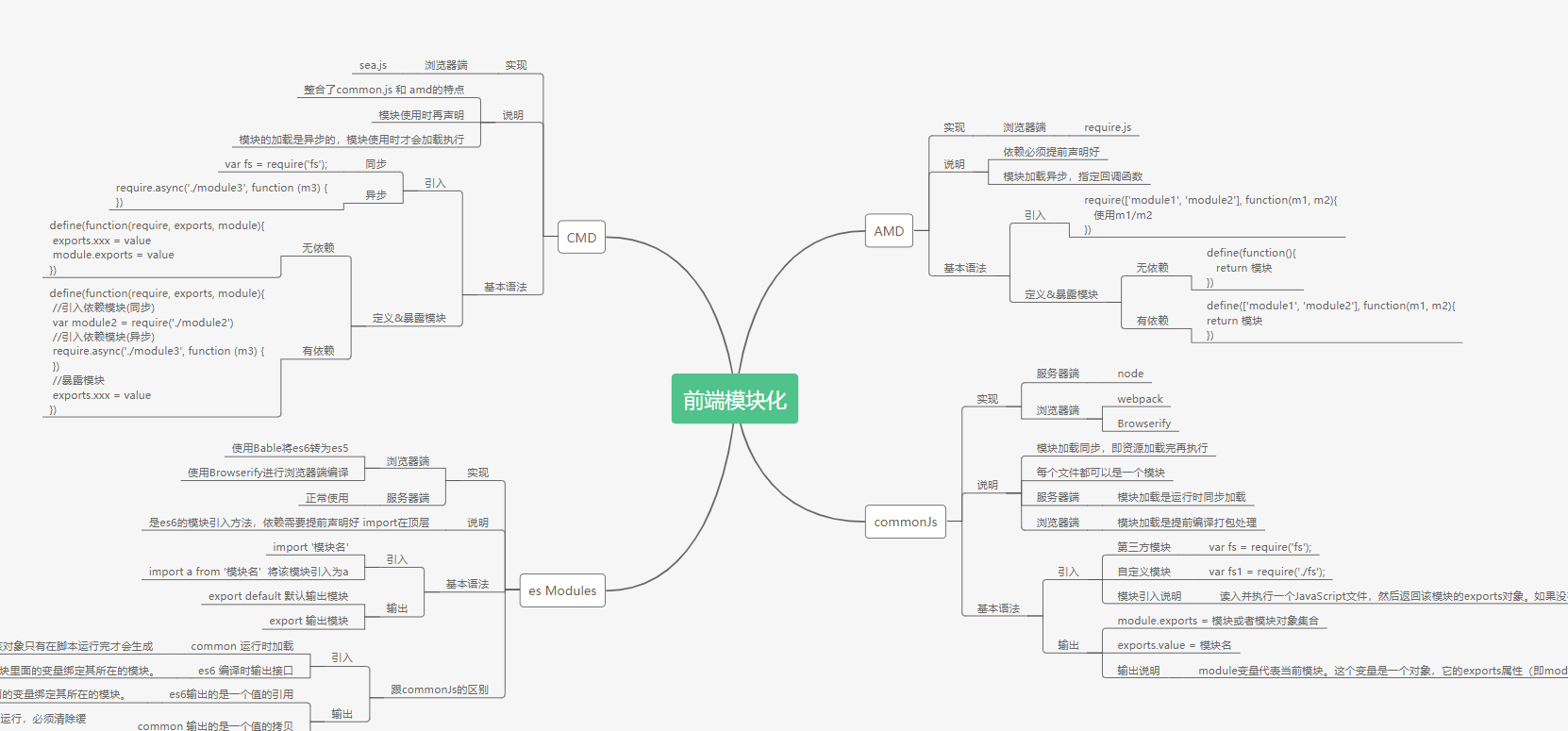JS模块化

学习视频:尚硅谷JS模块化教程
模块化进化史
全局function模式
1
2
3
4
5var msg = 'module1'
function foo () {
console.log('foo()', msg)
}
// foo()namespace模式
1
2
3
4
5
6
7let obj = {
msg: 'moudule2'
foo () {
console.log('foo()', this.msg)
}
}
// obj.foo()IIFE模式——匿名函数自调用(闭包)
1
2
3
4
5
6
7
8(function (window) {
let msg = 'module3'
function foo () {
console.log('foo()', msg)
}
window.module3 = {foo}
})(window)
// module3.foo()IIFE模式增强——引入依赖
1
2
3
4
5
6
7
8
9(function (window, $) {
let msg = 'module4'
function foo () {
console.log('foo()', msg)
}
window.module4 = foo
$('body').css('background', ' red')
})(window, jQuery)
// module4()造成问题:
- 请求过多
- 依赖模糊
- 难以维护
模块化规范
CommonJS
- 基本语法
- 暴露模块 module.exports = value ; exports.xxx = value
- 引入模块 require(xxx)
- 实现
- 服务器端实现 Node.js
- 浏览器端实现 CommonJs的浏览器端打包工具Browserify
AMD
说明:Asynchronous Module Definition(异步模块定义),专门用于浏览器,模块的加载是异步的
基本语法
暴露模块
1
2
3
4
5
6
7
8
9// 定义没有依赖的模块
define(function () {
return 模块
})
// 定义有依赖的模块
define(['module1', 'module2'], function (m1, m2) {
return 模块
})引入模块
1
2
3
4
5
6
7
8
9requirejs.config({
baseUrl: '',
paths: {
模块名:模块路径
}
})
require(['module1', 'module2'], function(m1, m2) {
使用m1/m2
})
实现 Require.js
CMD
说明:专门用于浏览器端,模块是异步的,使用时才会加载执行
基本语法
暴露模块
1
2
3
4
5
6
7
8
9
10
11
12
13// 定义没有依赖的模块
define(function(require, export, module) {
exports.xxx = value
module.exports = value
})
// 定义有依赖的模块
define(function (require, export, module) {
var module2 = require('./module2')
require.async('./module3', function (m3) {
})
exports.xxx = value
})引入模块
1
2
3
4
5
6define(function (require) {
var m1 = require('./module1')
var m4 = require('./module4')
m1.show()
m4.show()
})
实现(浏览器端) Sea.js
ES6
- 说明:依赖模块需要编译打包出来
- 语法
- 暴露模块 export
- 引入模块 import
- 实现(浏览器端)
- 使用Babel将ES6编译成ES5代码
- 使用Browserify编译打包js
ES6(常用)
1.定义package.json文件
1 | { |
2.安装
1 | npm install babel-cli browserify -g |
3.定义.babelrc文件
1 | { |
4.编码
js/src/module1.js 分别暴露
1 | // 分别暴露 |
js/src/module2.js 统一暴露
1 | // 统一暴露 |
js/src/module3.js 默认暴露
1 | // 默认暴露 |
js/src/main.js
1 | // import xxx from '路径' |
5.编译
使用Babel 将ES6编译为ES5代码
1
babel js/src -d js/lib
使用Browserify编译js,使包含CommonJS语法的js文件能在浏览器运行
1
browserify js/lib/main.js -o js/lib/bundle.js
6.html页面引入
1 | <script src="./js/dist/bundle.js" type="text/javascript"></script> |
7.打开html